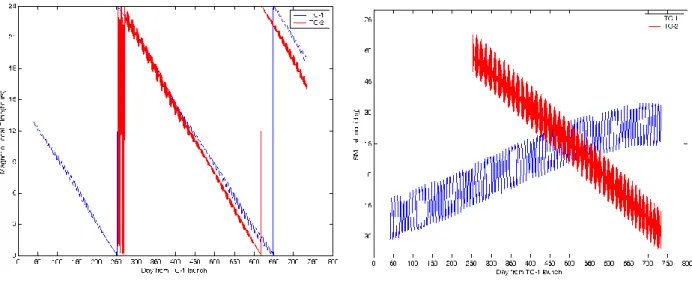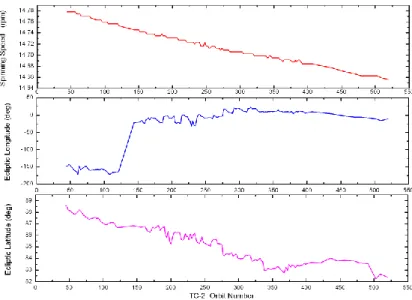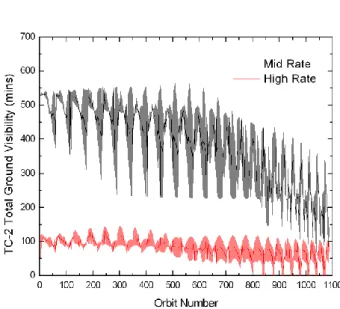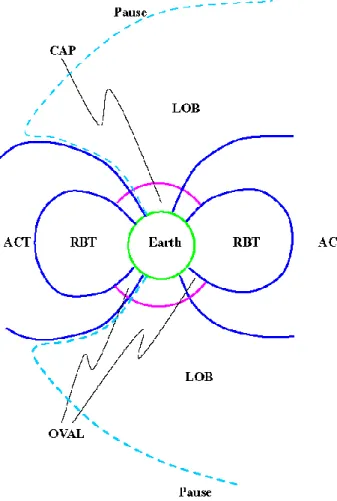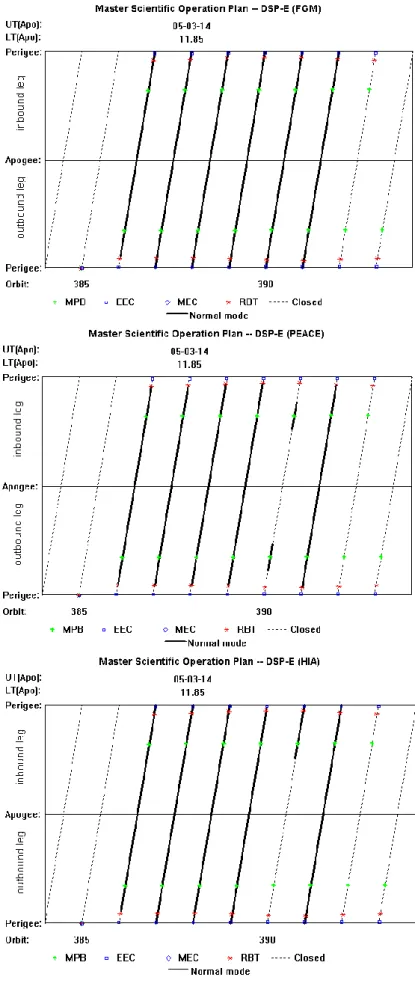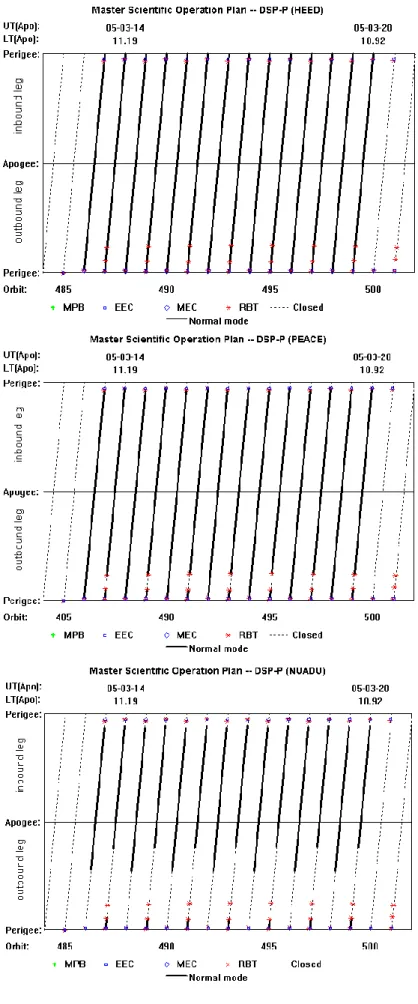HAL Id: hal-00317953
https://hal.archives-ouvertes.fr/hal-00317953
Submitted on 8 Nov 2005
HAL is a multi-disciplinary open access
archive for the deposit and dissemination of
sci-entific research documents, whether they are
pub-lished or not. The documents may come from
teaching and research institutions in France or
abroad, or from public or private research centers.
L’archive ouverte pluridisciplinaire HAL, est
destinée au dépôt et à la diffusion de documents
scientifiques de niveau recherche, publiés ou non,
émanant des établissements d’enseignement et de
recherche français ou étrangers, des laboratoires
publics ou privés.
Double Star project - master science operations plan
Chao Shen, Z. Liu
To cite this version:
Chao Shen, Z. Liu. Double Star project - master science operations plan. Annales Geophysicae,
European Geosciences Union, 2005, 23 (8), pp.2851-2859. �hal-00317953�
© European Geosciences Union 2005
Geophysicae
Double Star project – master science operations plan
C. Shen and Z. Liu
Key Laboratory of Space Weather, Center for Space Science and Applied Research, Chinese Academy of Sciences, P.O. Box 8701, Beijing 100080, China
Received: 7 March 2005 – Revised: 17 May 2005 – Accepted: 23 May 2005 – Published: 8 November 2005 Part of Special Issue “Double Star – First Results”
Abstract. For Double Star Project (DSP) exploration, the
scientific operations are very important and essential for achieving its scientific objectives. Two years before the launch of the DSP satellites (TC-1 and TC-2) and during the mission operating phase, the long-term and short-term mas-ter science operations plans (MSOP) were produced. MSOP is composed of the operation schedules of all the scientific instruments, the modes and timelines of the Payload Service System on TC-1 and TC-2, and the data receiving schedules of the three ground stations. The MSOP of TC-1 and TC-2 have been generated according to the scientific objectives of DSP, the orbits of DSP, the near-Earth space environments and the coordination with Cluster, etc., so as to make full use of the exploration resources provided by DSP and to acquire as much quality scientific data as possible for the scientific communities. This paper has summarized the observation resources of DSP, the states of DSP and its evolution since the launch, the strategies and rules followed for operating the payload and utilizing the ground stations, and the production of MSOP. Until now, the generation and execution of MSOP is smooth and successful, the operating of DSP is satisfac-tory, and most of the scientific objectives of DSP have been fulfilled.
Keywords. Magnetospheric physics (Solar wind-magnetosphere interactions; Storms and substorms; Instruments and techniques)
1 Introduction
Double Star Project (DSP) is composed of two small satel-lites orbiting the Earth in the equatorial and polar regions, which are not covered by the existing ISTP missions. The main scientific objectives are to detect the temporal-spatial variations of fields and particles in the equatorial and polar active regions, systematically explore the triggering mecha-nisms and global dynamical evolution processes of magneto-spheric space storms. Both of the equatorial satellite (TC-1) and polar satellite (TC-2) of DSP are equipped with 8
in-Correspondence to: C. Shen
(sc@center.cssar.ac.cn)
struments, the parameters of which may be referred to in the paper of Liu et al. (2005).
In order to achieve the scientific exploration objectives of DSP, the scientific operations of DSP have been given much emphasis. The purposes of the master science operations plan are to make full use of the exploration resources pro-vided by the spacecraft and ground stations, to coordinate the observations of TC-1, TC-2 and Cluster (Escoubet et al., 1997), and to meet the requirements of scientists, especially that of the payload terms, at various actual situations.
2 The basic states and exploration resources of DSP
2.1 The orbits of the Double Satellites
The orbit parameters of TC-1 and TC-2 of DSP are shown in Table 1. Figure 1 demonstrates the orbits of TC-1, TC-2 and Cluster on September 2004. Both of the two satellites have ellipse orbits. TC-1 can cross the inner and outer ra-diation belt, ring current region, plasmasphere, near-Earth plasma sheet, dayside low-latitude magnetopause, magne-tosheath and bow shock; while TC-2 may cross the southern polar cap region, southern auroral oval, radiation belt, plas-masphere, northern cusp and tail lobes.
Figure 2 shows the evolution of the positions of the apogee of TC-1 and TC-2. It can be seen that the orbits of TC-1 and TC-2 undergo processional motions at a rate of ∼2 h/month (30◦/month) clockwise, as well as that of Cluster (Escoubet et al., 1997; Hapgood et al., 1997). Generally, the apogee of TC1, TC-2 and Cluster have about the same local time, and the orbits of TC-2 and Cluster are almost within the same plane. The inclinations of TC-1 and TC-2 remain roughly unchanged. Therefore, the 6 S/C have ideal coordination for exploration during the whole DSP lifetime, thus yielding unique observation data of the global magnetospheric pro-cesses.
2.2 Attitude and maneuver
Both satellites are spin stabilized, with the spin axis per-pendicular to the ecliptic plane. The spin periods of both satellites are close to 4 s. The attitude and spinning rates of
2852 C. Shen and Z. Liu: Double Star project – master science operations plan
Table 1. Parameters of TC-1 and TC-2 after launch of TC-2.
S/C Parameters TC-1 (26 July 2004) TC-2 (27 July 2004)
Orbit pattern Ellipse Ellipse
Perigee Geocentric distance 6898.97 km 7065.376 km Apogee Geocentric distance 85 358.80 km or 13.4 Re 44 601.424 km or 7.0 Re
Inclination 28.2◦ 90.122◦
Kepler period 27.3885 h 11.478 h
Spin rate 14.69 rmp 14.79 rmp
Spin direction 89.9◦from the ecliptic plane 89.5◦from the ecliptic plane Expected Telemetry precision Near perigee: <4 km Near perigee: <4 km
Radial near apogee: <20 km Radial near apogee: <20 km
Mass 336.5 kg 343 kg
Power ∼300 W 306 W
Launch date 19:06 UT, 29 December 2003 15:05 UT, 25 July 2004 Expected Lifetime >18 months >12 months
Fig. 1. TC-1, TC-2 and Cluster orbits in GSE during 1–20 September 2004 viewed from the +Z (left panel) and +Y directions (right panel).
the two satellites vary slowly with time. Maneuvers are per-formed periodically so as to adjust the satellite attitude and spin periods. During the maneuver processes, HIA, PEACE and ASPOC of TC-1, and NUADU and LEID of TC-2 need to be switched off, in order to protect their sensors from con-tamination. Within the 0.5 h before and 2.5 h after the ma-neuver periods, HIA, PEACE, ASPOC, NUADU and LEID will be switched off.
The evolution of the TC-1 attitude is shown in Fig. 3. At the end of the commissioning phase (about orbit 50), the spin axis of TC-1 is almost along the normal of the ecliptic plane with an inclination angle of 89.7◦ from the ecliptic plane, while the spinning speed of TC-1 is 14.74 rpm with a spin
period of 4.071 s. One maneuver has been made on 13 July 2004 (orbit 171) to pull the attitude of TC-1 back to the nor-mal state, as indicated in Fig. 3. Unfortunately, by 8 Novem-ber 2004 (orbit 275) the two attitude control computers of TC-1 both failed, so that since then no maneuver could be made and its attitude parameters could only be determined on the ground by FGM data and Sun pulse data.
Figure 4 illustrates the evolution of the attitude param-eters of TC-2. After the launch of TC-2, its attitude has been adjusted to satisfactory values, as shown in Table 1. However, the two attitude control computers of TC-1 have been destroyed on 2 and 10 August 2004, respectively, most possibly caused by the extremely strong space hazard
Fig. 2. Evolution of the magnetic local time (left panel) and SM latitude (right panel) of the apogee of DSP with time as predicted. The
origin of the horizontal axis is the launch time of TC-1.
Fig. 3. Evolution of the TC-1 spinning speed (upper panel), the ecliptic latitude (mid panel) and ecliptic longitude (lower panel) of the spin
axis of TC-1. Note that the Kepler period of TC-1 is about 27.4 h.
event which occurred in July 2004 and lasted for about two weeks. During this space hazard, the flux of >2 Mev elec-tron at geosynchronoeus position reached a maximum value of about 3×105s−1·cm−2·sr−1, which was very rare in his-tory, and serious internal charging of the satellite systems could have been caused (Wrenn et al., 2002). At present, the attitude parameters of TC-2 can only be determined on the ground by FGM data and Sun pulse data.
Until now, the attitude of both TC-1 and TC-2 satisfies the requirements of the scientific payload. The spin rate of the two satellites should always meet the requirements of scien-tific payload within the whole planned lifetime of DSP.
2.3 Power supply and eclipse
The actual output powers of the solar batteries of TC-1 and TC-2 are about 312 W and 306 W, respectively, at the begin-ning of their lifetimes, much better than pre-launch expecta-tions. The decay of the powers of the solar batteries of TC-1 and TC-2 with time is much less (not larger than 20 W).
During long Earth eclipse periods, there may be a power shortage. Long eclipse and short eclipse are defined as that with durations longer and shorter than 120 min, respectively. Within the intervals of long eclipse, all of the payload of the corresponding satellites, except for FGM, STAFF, NUADU and the solid state recorder, have to be switched off, due to the shortage of satellite power supply. A short eclipse
2854 C. Shen and Z. Liu: Double Star project – master science operations plan
Fig. 4. Evolution of the TC-1 spinning speed (upper panel), the ecliptic latitude (mid panel) and ecliptic longitude (lower panel) of the spin
axis of TC-2. Note that the Kepler period of TC-2 is about 11.5 h.
Fig. 5. Schematic illustration of the ground visibilities of the two DSP satellites from the three ground stations. The orbits of TC-1 and TC-2
are plotted with dashed lines. The ground is demonstrated as one black horizontal line, on which the Beijing station (BS), Villafranca station (VS) and Shanghai station (SS) are marked. The boundaries of the ground visibilities at high and mid data dumping rates are shown as red and blue circles, respectively.
will not affect the power supply of both satellites and all the instruments can be switched on. For TC-1, from Au-gust through September of 2004, long Earth eclipses oc-cured, with the longest one having a duration of 278 min; the next long Earth eclipse of TC-1 will appear during late October and early November of 2006. For TC-2, there is no long eclipse during its lifetime; but the long Earth eclipse of TC-2 may appear during early September of 2005.
2.4 Payload data recording and dumping
Both of the Solid State Recorders (SSR) on board the equato-rial and polar satellites have a volume of about 2 Gbits. SSR will record both engineering data and scientific data. The total data rates of TC-1 and TC-2, including that of the Pay-load Service System and the eight payPay-loads, are 15 515 bps and 16 567 bps, respectively. The maximum volumes of the observed scientific data per orbit for TC-1 and TC-2 are 1.4 Gbits and 0.67 Gbits, respectively. Therefore, SSR on board TC-1 and TC-2 can record 1.4 orbits and 3 orbits of observed data, respectively.
There are three data dumping rates, 1024 kbps, 128 kbps and 16 kbps, for three different heights of DSP, respectively.
If the payloads on board the two satellites are operating full time with no disruption, 0.5 h/4 h/35 h per obit are needed for the data downlink at the rates 1024 kbps/128 kbps/16 kbps for TC-1; while 0.2 h/1.9 h/14.6 h per obit are needed for the data downlink at the rates 1024 kbps/128 kbps/16 kbps for TC-2. The allowed overall durations for data downlink for TC-1 and TC-2 are less than 5 h and 3 h, respectively.
There are three ground stations, Beijing station (BS), Shanghai station (SS) in China and Villafranca station (VS) in Spain, which are applicable for receiving the dumped data of TC-1 and TC-2. Figure 5 demonstrates the visibilities of the three ground stations from TC-1 and TC-2.
The basic principles followed during the S/C data dumping and data receiving by the ground stations are as follows:
1. The data receiving of TC-1 is preferred to that of TC-2; 2. The priority rule of data dumping modes is
High rate – middle rate – low rate;
3. The priority rule of the three ground stations is
Beijing station – Villafranca station – Shanghai station. Thus, we may have a unique best choice for various ground pass situations.
Table 2. The coordinated observations of TC-1, TC-2 and Cluster.
Magnetospheric processes Exploration regions of TC-1 Exploration regions of TC-2 Exploration regions of CLUSTER Substorms / magnetic storms Near-Earth plasma sheet (With the apogee Aurora oval / Polar cap / Ring current Plasma sheet (x∼−20RE)and Ring current (in summer) at about midnight, x∼−13.4 RE) (With the apogee at about midnight) (x∼4 RE)
Magnetopause boundary Dayside LLBL (With the apogee at Aurora oval / Polar cap /Cusp Solar wind / Bow shock / Sheath / Cusp/HLBL layer dynamics (in spring) about noon, x∼−13.4 RE) (With the apogee at about noon)
Interplanetary shock impact Solar wind / Bow shock / Sheath / LLBL/ Aurora oval / Polar cap / Cusp Solar wind / Bow shock / Sheath / Cusp/ HLBL Radiation belt / Ring current (With the apogee at about noon)
(With the apogee at about noon)
Transferring processes from Sheath / LLBL/ Plasma sheet Aurora oval / Polar cap / Cusp Sheath / Dawn or Dusk magnetopause solar wind to magnetosphere (With the apogee at dawn / dusk) (With the apogee at dawn / dusk) boundary layer
Fig. 6. TC-1 satellite total visibility at high and mid data dumping
rates from the three ground stations.
The total effective ground visibility from the three ground stations for the two DSP satellites is demonstrated in Figs. 6 and 7. It can be expected that most of the observation data of DSP satellites can be dumped and received by the three ground stations at high and mid data rates.
3 DSP master science operations plan
3.1 DSP exploration regions of geomagnetosphere To fulfill the scientific objectives, TC-1 is to explore the ra-diation belt, plasmasphere, ring current, plasma sheet, mag-netopause, magnetosheath, bow shock, while TC-2 explores the radiation belt, plasmasphere, ring current, polar regions (auroral oval and polar cap), cusp and lobe regions. Figure 8 illustrates the DSP exploration regions. Priority rule given to the exploration regions is:
Active regions – Polar regions (>15 min) – Radiation belt – Lobe.
Fig. 7. TC-2 satellite total visibility at high and mid data dumping
rates from the three ground stations.
3.2 Coordination between TC-1, TC-2, CLUSTER and ground observations
As shown in Sector 2.1, the orbits of TC-1, TC-2 and Clus-ter can well be coordinated for joint explorations to magne-tosphere processes. TC-1 and TC-2 occupy equatorial and polar exploration areas, respectively. The apogees of TC1, TC-2 and Cluster always have about the same local time. Ta-ble 2 shows some coordinated observations of the equatorial and polar satellites of DSP with Cluster.
During the actual scientific operations of DSP, Hapgood of EPOS generates the quantitative time tables for the coor-dinated observations of TC-1, TC-2 and Cluster based on the approach for Cluster and ground-based coordination (Lock-wood and Opgenoorth, 1997; Opgenoorth and Lock(Lock-wood, 1997; Hapgood et al., 1997), and DSP Scientific Operations Center will ingest these time tables into the weekly scientific operation plans of DSP.
DSP exploration has been carried out in coordination with ground detections at different latitudes and polar observa-tions. Various ground instruments and observatories, such as
2856 C. Shen and Z. Liu: Double Star project – master science operations plan
Fig. 8. Demonstration of regions in near-Earth magnetopause
ex-plored by DSP. RBT means the radiation belt, ACT indicates the active regions including ring current, plasma sheet, magnetopause and cusp, and LOB marks the lobes.
those of Zhongshan Station and Great Wall Station in Antarc-tica, SuperDarn, etc., have joined in the coordination obser-vations.
3.3 Operation modes of DSP payloads
The regulations for the operations of the payloads listed be-low have been folbe-lowed during the DSP explorations:
1. In the radiation belt the energetic and high energy par-ticles may cause fatal damages to PEACE, ASPOC and NUADU, so that these payload need to be switched off within the radiation belt.
2. During the long-term Earth eclipses or moon eclipses with intervals longer than 180 min, all the payload, ex-cept FGM and SSR, have to be switched off due to the limitation of power supply. For short Earth eclipses or moon eclipses, all the payloads can operate contin-uously.
3. During the orbits with very short intervals of visibility from ground stations, payloads with high date rates are
possibly switched off in secondary exploration regions. The active regions (magnetopause, plasma sheet, ring current and cusp) have been given higher priority for explorations.
4. Within the 0.5 h before and 2.5 h after the maneuvers, when gas is released, HIA, PEACE, ASPOC, NUADU and LEID will be switched off.
5. ASPOC can be switched off during the Earth eclipses and Moon eclipses.
3.4 Master science operations plan
The long-term scientific observation activities of DSP have been planned and some have already been executed as fol-lows:
(1) Period December 2003 – February 2004: Launch of TC-1 and commissioning of the payloads. Payloads that complete their commissioning tests will start the observa-tions. Effort has been made to obtain as much effective sci-entific data as possible during this period. During this phase, the dayside magnetospheric processes have been explored by TC-1 in coordination with Cluster.
(2) Period March 2004 – June 2004: The spring explo-ration campaign has been carried out in coordination with Cluster and ground observations to investigate the global evolution of the dawn side magnetospheric processes.
(3) Period July 2004 – October 2004: Launch of TC-2 and commissioning of the payloads during July–August 2004. Payloads have joined in the explorations after the completion of the commissioning tests. During this phase, the nightside magnetospheric processes, including storms and substorms, have been explored by TC-1 and TC-2 with the coordination of Cluster.
(4) Period November 2004 – January 2005: Dusk side magnetospheric processes have been explored by TC-1 and TC-2 in coordination with Cluster.
(5) Period February 2005 – April 2005: Dayside magne-tospheric processes are explored by TC-1 and TC-2 in coor-dination with Cluster.
(6) Period May 2005 – July 2005: Dawn side magneto-spheric processes are to be explored by TC-1 and TC-2 in coordination with Cluster. The apogee of TC-2 has dropped onto the vicinity of ecliptic plane during this period.
(7) After July 2005: The expected end of DSP. It has just been decided that another 1.5-year long operation of DSP will be further carried out, thus the 6-point space exploration will continue.
The master science operation plan (MSOP) is composed of the operation schedules of all 16 scientific instruments, the modes and timelines of the Payload Service System on TC-1 and TC-2, and the data receiving schedules of the three ground stations. The production of the master science opera-tion plans of TC-1 and TC-2 is based on the scientific objec-tives of DSP, the orbits of DSP, the near-Earth space environ-ments and the coordination with Cluster, etc., so as to make full use of the detection resources offered by DSP and obtain
Fig. 9. The Bryant plots of the op-eration plans of FGM (upper panel), PEACE (mid panel) and HIA (lower panel) of TC-1 during the plan-ning period 65 (orbit 386–391) on 14–21 March 2005. In the Bryant plots, the operation of payloads for each or-bit has been illustrated as one lean-ing line segment startlean-ing and endlean-ing at the perigee, with the switched-on state denoted as thick black lines and the switched-off state as dashed ones. The horizontal axis is the orbit time marked by orbit numbers, the date and local time of the apogee have also been given above the upper horizontal axis, while the vertical axis shows the time of one orbit period with the apogee at the center. The operations plan of HEED/HEPD/HID is the same as that of FGM; the operations plan of ASPOC is the same as that of PEACE; the op-erations plan of STAFF is similar to that of HIA. The green crosses mark the magnetopause boundaries (MPB), red asterisks mark the boundaries of the ra-diation belt (RBT), and the blue squares and diamonds denote the Earth eclipse and Moon eclipse, respectively.
2858 C. Shen and Z. Liu: Double Star project – master science operations plan
Fig. 10. The Bryant plots of the
op-eration plans of HEED (upper panel), PEACE (mid panel) and NUADU (lower panel) of TC-2 during the plan-ning period 65 (orbit 486–499) on 14–21 March 2005. The operations plan of FGM/HEPD/HID/LEID/LEFW is the same as that of HEED. The mean-ings of the symbols in the plots are the same as that of Fig. 9.
as much good scientific data as possible for scientific com-munities. The long-term MSOP commonly span one year or 1.5 year, and is generated in advance for the scientists. The short-term MSOP are one week long and produced weekly. Generally, the payload can be operated within most of the in-tervals of the orbits of TC-1 and TC-2 due to the sufficient DSP S/C data dumping and ground station receiving abili-ties. Figures 9 and 10 show the Bryant plots (Hapgood et al., 1997) of the short term MSOP of the payload of TC-1 and TC-2, respectively, for the planning period 65. During this week, FGM of TC-1 and TC-2 are running continuously, only disrupted by the S/C main-redundant switching activity (performed about once every two months) at the start of the first orbit of this planning period. HEED, HEPD, HID, LEID and LEFW are also operating continuously. PEACE, AS-POC and NUADU are switched off within the radiation belt. In order to avoid the influence of the ring current charged particles, the switched-off intervals of NUADU have been extended. For TC-1, there is not enough ground visibility at orbit 390, so that the observation intervals of PEACE, AS-POC, HIA and STAFF have been shortened at this orbit with emphasis on the magnetopause crossing explorations.
By March 2005, the explorations of TC-1 and TC-2 have been carried out for about 15 months and 8 months, and the scientific operations are smooth and satisfactory. Most of the observation objectives of DSP have been fulfilled. The execution results indicate that the master science op-eration plans produced are reasonable, applicable and have achieved success. Until now, both S/C of DSP are in a normal state; after July 2005 (the designed end of lifteime of DSP), the exploration resource of DSP should be still capable of supporting another 1.5-year long observation to magnetospheric processes, in coordination with the Clus-ter mission and ground measurements, for example, dayside magnetopause-cusp processes and global dynamics of mag-netospheric substorm and storm at nightside.
4 Conclusions
This paper has summarized the observation resources of DSP, the states of DSP and its evolution since the launch, the strategies and rules followed for operating the payload and applying the ground stations, and the production of MSOP. TC-1, TC-2 and Cluster have excellent coordinated orbits and are able to successfully make 6-point explorations to global magnetospheric processes. The attitudes of TC-1 and TC-2 meet the requirements of the observations of the in-struments. The power supplies of both TC-1 and TC-2 are sufficient for DSP operations. The S/C data dumping and ground station receiving abilities permit the scientific pay-load operating in most of the intervals of the orbits. Two years before the launch of the DSP satellites (1 and TC-2) and during the mission operating phase, the long-term and short-term MSOP have been produced. MSOP are composed of the operation schedules of all the scientific instruments, the modes and timelines of the Payload Service System on
TC-1 and TC-2, and the data receiving schedules of the three ground stations. The MSOP of TC-1 and TC-2 have been generated according to the scientific objectives of DSP, the orbits of DSP, the near-Earth space environments and the co-ordination with Cluster, etc., so as to make full use of the ex-ploration resources provided by DSP and to acquire as much quality scientific data as possible for the scientific communi-ties. Until now, the generation and execution of MSOP have been smooth and successful, the operating of DSP is satisfac-tory, and most of the scientific objectives of DSP have been fulfilled. It is expected that DSP could complete its scien-tific objective as scheduled and further perform explorations beyond its designed lifetime.
Acknowledgements. The authors are grateful for all the valuable
suggestions and help provided by colleagues, which are essential for carrying out the scientific operations of DSP. The authors are also thankful to Q. Liu for the accurate orbit calculations for DSP. This work was supported by National Natural Science Foundation of China Grant No. 40125012 and 40390150, Chinese Academy of Sciences, and Ministry of Science and Technology of China Grant No. G20000784.
Topical Editor T. Pulkkinen thanks M. A. Hapgood and S. Milan for their help in evaluating this paper.
References
Escoubet, C. P., Schmidt, R., and Goldstein, M. L.: Cluster-Science and mission overview, in: Cluster and Phoenix Missions, edited by: Escoubet, C. P., Russell, C. T., and Schmidt, R., 11, Kluwer Academic Publishers, Belgium, 1997.
Hapgood, M. A., Dimbylow, T. G., Sutcliffe, D. C., Chaizy, P. A., Chaizy, P. A., Ferron, P. S., Hill, P. M., and Tiraway, X. Y.: The joint scientific operations center, in: Cluster and Phoenix Mis-sions, edited by: Escoubet, C. P., Russell, C. T., and Schmidt, R., Kluwer Academic Publishers, Belgium, 487, 1997.
Hapgood, M. A.: Uses and abuses of field-line tracing, in: Satellite-Ground Based Coordination Sourcebook, edited by: Lockwood, M., Wild, M. N., and Opgenoorth, H. J., ESA Publication Divi-sion, The Netherlands, 335, 1997.
Liu, Z. X., Escoubet, C. P., Pu, Z., Laakso, H., Shi, J. Q., Shen, C., and Hapgood, M.: The Double Star mission, Ann. Geophys., 23, 2707–2712, 2005.
Lockwood, M. and Opgenoorth, H. J.: Principles of combined ground-based and satellite studies of solar-terrestrial phenomena, in : Satellite-Ground Based Coordination Sourcebook, edited by: Lockwood, M., Wild, M. N., and Opgenoorth, H. J., ESA Publi-cation Division, The Netherlands, 3, 1997.
Opgenoorth, H. J. and Lockwood, M.: Opportunities for magneto-spheric research with coordinated Cluster and ground-based ob-servations, in: Cluster and Phoenix Missions, edited by: Escou-bet, C. P., Russell, C. T., and Schmidt, R., Kluwer Academic Publishers, Belgium, 599, 1997.
Wrenn, G. L., Rodgers, D. J., and Ryden, K. A.: A solar cycle of spacecraft anomalies due to internal charging, Ann. Geophys., 20, 953–956, 2002,

